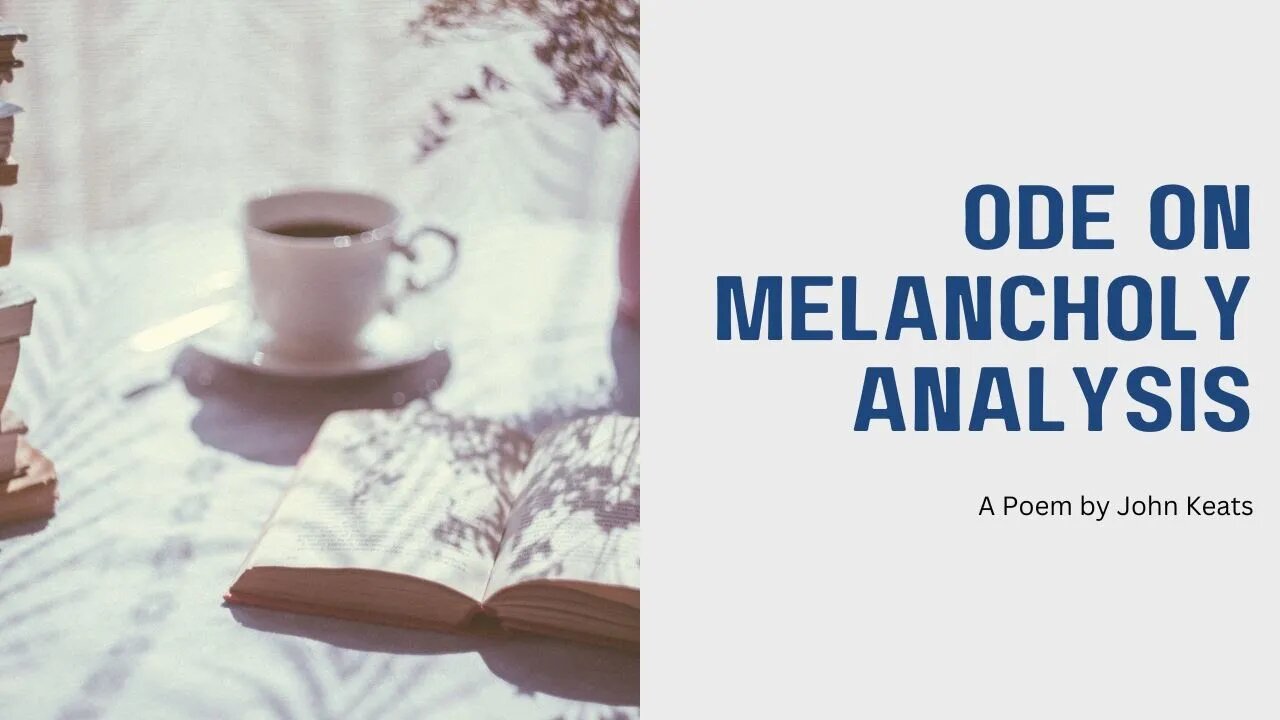Premium Only Content

Ode on Melancholy by John Keats Analysis
Today, we embark on a poetic journey to unravel the beauty and depth of John Keats' timeless masterpiece, "Ode on Melancholy." This enchanting poem explores the profound emotion of melancholy in a way that resonates with us all.
In the opening lines, Keats invites us to embrace melancholy as an integral part of the human experience. He calls it a "deity" that dwells among us, urging us to "glut" our sorrows and accept the fleeting nature of joy.
Keats acknowledges that our human hearts are bound to experience moments of sadness and despair, but he advises us not to shy away from these feelings. Instead, he urges us to let melancholy wash over us like a gentle rain, cleansing our souls.
Moving forward, Keats delves into the profound connection between beauty and melancholy. He reveals that true beauty emerges from the depths of sorrow, like a bright flower blooming amidst darkness.
He reminds us that the most enchanting and poignant moments in life often carry a touch of sadness, like the bittersweet longing in the eyes of a distant lover or the fading colors of a sunset.
As we venture deeper into the poem, Keats cautions us against seeking pleasure in superficial distractions to escape melancholy. He warns that indulging in excesses of joy may dull the richness of life's experiences.
Keats encourages us to cherish and savor moments of sadness, for they can lead us to profound insights and a deeper understanding of the world and ourselves.
In the final verses, Keats addresses the concept of "beauty that must die." He reminds us that life's fleeting nature adds to its profound beauty, like the ephemeral brilliance of a rainbow or the brief splendor of spring blooms.
Keats advises us to embrace both the joys and sorrows of life, for they are intertwined and give meaning to our existence. By experiencing the depth of melancholy, we can better appreciate life's joys when they come our way.
Themes in Ode on Melancholy.
Embracing Melancholy.
One of the central themes in "Ode on Melancholy" is the acceptance and embrace of melancholy as an intrinsic part of the human experience. Keats portrays melancholy not as a curse but as a deity that enriches our souls with profound emotions and insights.
The poem encourages us to acknowledge and cherish moments of sadness, for they can lead us to a deeper understanding of ourselves and the world around us.
Beauty and Transience.
Another prominent theme is the intricate relationship between beauty and transience. Keats highlights that true beauty often emerges from moments of sadness, like a delicate flower blooming amidst darkness.
The poem reminds us that life's most enchanting moments are fleeting, like the brilliance of a rainbow or the transient splendor of spring blooms. These fleeting beauties are to be cherished, for they add depth and meaning to our lives.
Symbols in Ode on Melancholy.
The Flower.
Among the symbolic elements in the poem, the flower holds a significant meaning. It represents the fragile and transient nature of beauty and joy. Just like a flower withers and fades, so do life's most delightful moments.
Through this symbol, Keats emphasizes the importance of appreciating and savoring beauty while it lasts, as its impermanence makes it all the more precious.
The Rainbow.
The rainbow is another potent symbol in "Ode on Melancholy." It represents the ephemeral nature of happiness and joy. A rainbow's radiant colors quickly vanish, mirroring the transient joys of life.
Literary Device in Ode on Melancholy.
Imagery.
Keats employs vivid imagery throughout the poem to paint evocative pictures in the reader's mind. His descriptions of nature, emotions, and fleeting beauty immerse us in the poem's themes.
Alliteration.
In "Ode on Melancholy," Keats skillfully employs alliteration, using repetitive consonant sounds to create a musical effect. This lyrical quality enhances the poem's emotional resonance.
The gentle repetition of sounds reinforces the poem's themes and enriches the overall reading experience.
-
 LIVE
LIVE
Glenn Greenwald
3 hours agoGlenn Takes Your Questions on Tulsi's Russiagate Revelations, Columbia's $200M Settlement, and More | SYSTEM UPDATE #492
8,904 watching -
 LIVE
LIVE
Akademiks
42 minutes agoICE MAN EPISODE 2 tonight. NEW NBA YOUNGBOY 'MASA' TONIGHT. BIG AKADEMIKS #2 MEDIA PERSONALITY 2025.
1,844 watching -
 LIVE
LIVE
LumpyPotatoX2
2 hours agoRumble Creator Round-Table - Let's Talk About It
243 watching -
 LIVE
LIVE
The Mel K Show
4 hours agoMel K & Dr. James Thorp, MD | Sacrifice: The Targeting of the Most Vulnerable | 7-24-25
352 watching -
 LIVE
LIVE
Omar Elattar
6 hours agoThe Dating Expert: "I've Helped 4,000 Men Find LOVE!" - The #1 Alpha Trait Women Secretly Crave!
15 watching -
 1:12:41
1:12:41
Donald Trump Jr.
3 hours agoFrom Crypto to AI, There's a New American Energy Revival, Interviews with Asher Genoot & Sen McCormick | TRIGGERED Ep.261
124K45 -
 52:11
52:11
ZeeeMedia
6 hours ago"Meaningful Deep State Prosecution" ft. Robert Barnes | Daily Pulse Ep. 73
3.26K2 -
 8:10
8:10
MattMorseTV
4 hours ago $0.39 earnedThey just CAVED.
8159 -
 LIVE
LIVE
Tundra Tactical
4 hours agoTundra's EXPLOSIVE SIG Meme Review
33 watching -
 LIVE
LIVE
Joker Effect
1 hour agoThe told me to go to H3LL...... well... I am here and causing chaos now. HORROR GAMEPLAY ONLY! :)
419 watching